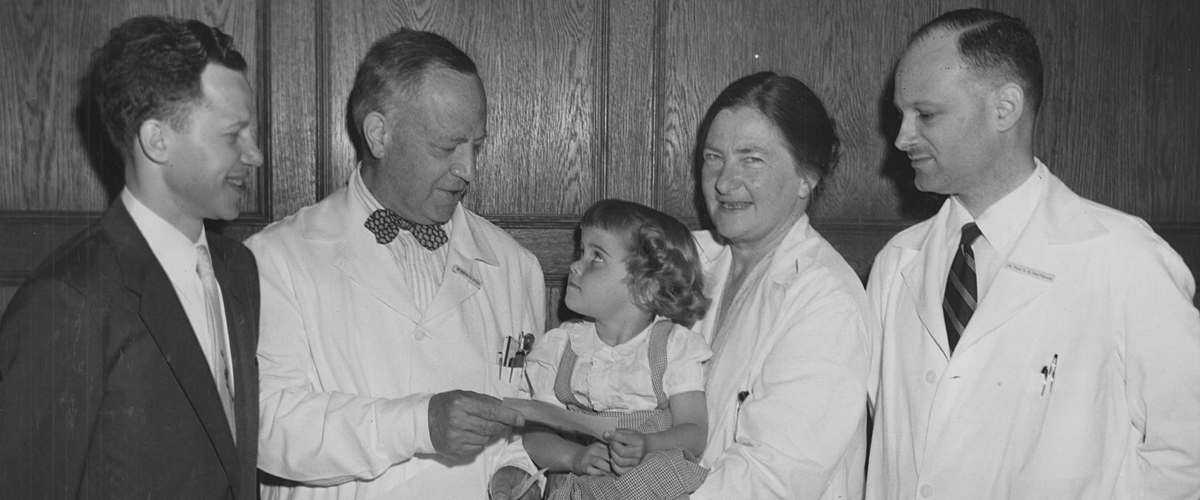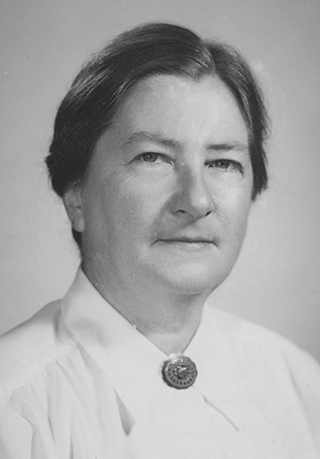It Happened Here: Dr. Dorothy H. Andersen
Despite limited opportunity and gender discrimination, in the early 20th century this researcher identified a disease — cystic fibrosis.

For centuries, the fear of having a “salty child” — or one with skin that was abnormally briny — was a common one.
That’s because many of these children were unable to properly regulate chloride levels within their cells, which led them to eventually suffer from persistent lung infections, pneumonia and bronchitis, shortness of breath, and stunted growth. Most rarely survived past childhood.
It wasn’t until 1938 that this disorder was properly identified. That’s when Dr. Dorothy H. Andersen, an assistant attending pediatrician and assistant pathologist at what was then known as Babies Hospital (now NewYork-Presbyterian Morgan Stanley Children’s Hospital), discovered and named cystic fibrosis (CF), a genetic disorder that causes a thick, sticky mucus to build up in the lungs, pancreas and other organs, leading to life-threatening breathing and digestive problems. This discovery led to subsequent research that identified the basic mechanism of the disease, which allowed for development of diagnostic testing, and ultimately led to earlier treatment.
Today, the average life span of an individual with the disease is 44 years, according to the Cystic Fibrosis Foundation.
“Back in the 1700s, there was an expression, ‘Woe to the child with the salty kiss, for he will soon die,’” recalls Dr. Emily DiMango, director of the Gunnar Esiason Adult Cystic Fibrosis and Lung Program at NewYork-Presbyterian/Columbia University Irving Medical Center and a professor of medicine at Columbia University Vagelos College of Physicians and Surgeons. “We think that probably referred to the salty skin of babies with cystic fibrosis.
“Dorothy Andersen was very integral to the story of cystic fibrosis, because she was the one who identified it as a distinct disease. Before that, these children were classified as having celiac disease,” Dr. DiMango continues. “I think it’s remarkable that a woman made these tremendous strides in 1938, and I would imagine it was hard for her work to be accepted in that era.”
It was during a routine autopsy on a child who was thought to have had celiac disease that Dr. Andersen noticed a lesion in the pancreas. Intrigued, she searched autopsy records and medical literature, and discovered a discrete disease pattern. She called this pattern cystic fibrosis.
“Cystic fibrosis affects the lungs, the pancreas, and the liver, but the lungs and the pancreas particularly,” says Dr. Joshua R. Sonett, chief of general thoracic surgery and director of the Price Family Center for Comprehensive Chest Care at NewYork-Presbyterian/Columbia University Irving Medical Center. “When Dr. Andersen saw these abnormalities in the pancreas, she then went into further studies and correlated it to disease in the lung — thus coining and then studying cystic fibrosis for the pancreas.”
I think it’s remarkable that a woman made these tremendous strides in 1938, and I would imagine it was hard for her work to be accepted in that era.
Dr. Emily DiMango
Dr. Andersen wrote her first paper on her discovery in 1938, called “Cystic Fibrosis of the Pancreas and its Relation to Celiac Disease,” which was published in the American Journal of Diseases of Children. Over the next 20 years she conducted additional research into why the pancreas in these cadavers was abnormal. She and her team of researchers then moved from studying the organs of cadavers to studying and diagnosing CF in living people.
Dr. Andersen’s groundbreaking work spurred myriad advancements in CF research. In 1955, her fellow researcher at Columbia, Dr. Paul di Sant’Agnese, devised the “sweat test,” which measures the concentration of chloride that is excreted in sweat. Dr. di Sant’Agnese recognized that children with cystic fibrosis of the pancreas were very susceptible to dehydration, hypothesizing that a salt imbalance causes the disease. The sweat test remains the gold standard in CF screening today.
Defying the Odds
Dorothy Andersen was born in Asheville, North Carolina, in 1901, and at age 13 moved with her mother to Vermont after the death of her Danish father. She graduated from Saint Johnsbury Academy and Mount Holyoke College, and received her medical degree from Johns Hopkins University School of Medicine in 1926. Dr. Andersen then returned to the Northeast, where she completed a surgical internship at Strong Memorial Hospital in Rochester, New York, and taught anatomy at the University of Rochester.
Despite her accomplishments, Dr. Andersen was denied a surgical residency at Strong because of her gender. She sought, and earned, a spot in the Department of Pathology at the Columbia University College of Physicians and Surgeons in 1929. While an instructor of pathology at Columbia, between 1929 and 1935, Dr. Andersen studied endocrine glands and female reproduction.

Dr. Dorothy H. Andersen
Courtesy: Archives & Special Collections, Columbia University Health Sciences Library
She also showed an interest in inherited malformations of the heart. After earning a doctorate in medical sciences in 1935, Dr. Andersen was named assistant pathologist at Babies Hospital. In her new role, “she would study the hearts of deceased pediatric patients and try to understand their defects,” says Dr. Sonett. “By keeping the specimens labeled and categorized, she integrated her basic studies of why children die with these bad hearts into the training programs of the surgeons at the time, so that they could see what the defects were and start to understand how to fix them at a time when cardiac surgery was in its infancy.”
In 1959, she was given the role of attending pathologist at what was then known as Columbia-Presbyterian Hospital, and appointed a full professor of pathology at Columbia University College of Physicians and Surgeons.
Dr. Andersen considered herself a rugged individualist, and was a carpenter too. She enjoyed entertaining guests by throwing “glüg” parties, named for a Scandinavian drink similar to mulled red wine. Professionally, she was an honorary fellow of the American Academy of Pediatrics and an honorary chair of the National Cystic Fibrosis Research Foundation. She also won the Elizabeth Blackwell Award in 1954. Dr. Andersen died of lung cancer at NewYork-Presbyterian/Columbia on March 3, 1963.
Today, more than 80 years after her initial discovery, Dr. Andersen’s breakthrough still resonates.
“Most people with CF are diagnosed during childhood, but because of the improving therapies that have built on Dr. Andersen’s discovery, now more than 50 percent of patients with CF living in the U.S. are adults,” says Dr. DiMango. “CF is just a remarkable story that extends now into what precision medicine can do for patients. It all started with Dorothy Andersen. It’s hard to know how much that would have been delayed if she had not really taken the initiative to identify and report on this disease so many decades ago. All we know about cystic fibrosis goes back to her.”
